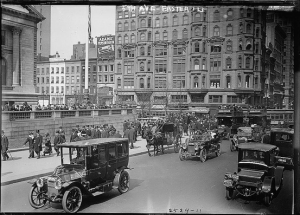The bottom line and definition of lean manufacturing is the relentless elimination of waste. In short, waste is anything that does not add value to what a company produces. Waste is found in all areas of a company and may include: materials, time, human resources, and capital.
In the early 20th century Ford Motor Company, Henry Ford relentlessly pursued the elimination waste, which allowed a Model T to go from raw iron ore to a finished car in just four days!

Looking at lean manufacturing history revels that at the end of World War II, Toyoda Kiichiro president of the Toyota Motor Company issued a challenge to his company: “Catch up with America in three years. Otherwise, the automobile industry of Japan will not survive.”
 At that time the USA was the undisputed heavy weight champion of world manufacturing productivity. In addition to the brave men and women who sacrificed mightily, this production prowess is largely credited with the allied victories.
At that time the USA was the undisputed heavy weight champion of world manufacturing productivity. In addition to the brave men and women who sacrificed mightily, this production prowess is largely credited with the allied victories.
Taiichi Ohno of Toyota spent considerable time analyzing American mass production and other examples of the USA’s expertise creating efficiencies. He and Shigeo Shingo are given much of the credit for developing the Toyota Production System or TPS. In his book he openly gives credit to American sources. In fact during the fifties Henry Ford’s wonderful book Today and Tomorrow was out of print in the United States and a best seller in Japan.
In the late seventies and eighties the Toyota Production System came to this country via forward thinking industry people and academia. During this period it was know as Just-in-Time or JIT. Bob Hall of the University of Indiana was a key early advocate and is still very active through the efforts of the Association of Manufacturing Excellence (AME). In 1990 Jim Womack wrote a seminal book on the topic using the “Lean” moniker.
In the twenty-first century Lean Manufacturing has evolved to Lean Enterprise, meaning that lean principles and techniques can be successfully applied across an organization in all business processes. This demonstrates that fully realized, Lean Manufacturing is a cultural phenomenon, not only a set of tools.
The goal of lean manufacturing implementation and lean enterprise is to deliver exactly what the customer wants, exactly when the customer wants it. This helps businesses avoid such profit-killers as stockpiling inventory or parts that don’t move, or performing services and intermediate steps that the client neither wants nor needs. The Toyota Production System now sets the standard for manufacturing operations. The battle GM and Ford are engaged in was never about makes and models; it’s about the success of two different management systems.
By AEM Consulting Group, Inc.
